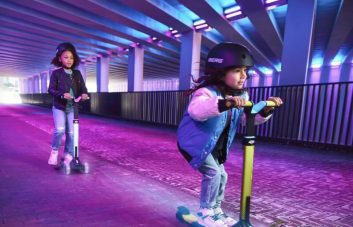Every parent knows that gleam in their child’s eye when they first mount a scooter: the promise of speed, wind rushing past, and the thrill of the ride. But with that exhilaration comes the responsibility to ensure our little ones are safe. Here’s your guide to kids’ scooter safety.
Why Safety Matters
Just as we wouldn’t let our kids go out on a bicycle without the proper precautions, the same holds true for scooters. While they might seem innocuous, even a small mishap at a low speed can lead to bruises, scrapes, or worse. Prioritising safety ensures that our kids can have fun, build confidence, and develop their skills without the shadow of avoidable accidents.
Essential Gear: Non-Negotiables for Safe Scooting
- Helmets: The first line of defense against injuries. Ensure the helmet fits snugly, sits low on the forehead, and doesn’t wobble side-to-side.
- Knee and Elbow Pads: Especially important for beginners, these pads protect against the most common scooter injuries: scrapes and bruises from falls.
- Wrist Guards: Since kids often extend their hands when they fall, wrist guards can help prevent fractures and sprains.
- Closed-toe Shoes: Flip-flops or sandals can easily come off or get caught during a ride. Closed-toe shoes provide better grip and protection.
- Reflective Gear or Lights: If your child rides in the evening or in low-light areas, reflective gear ensures they’re visible to others.
Teaching Your Child: Start Young and Start Right
- For Toddlers (Including 2-Year-Olds):
- Pick the Right Scooter: For toddlers, a three-wheeled scooter provides the stability they need.
- Start Slow: Let them get a feel for the scooter indoors or in a safe, enclosed space.
- Hand Positioning: Teach them to always keep both hands on the handlebars.
- Foot Positioning: Demonstrate how to keep one foot on the deck while pushing off gently with the other.
- Practice Stopping: Ensure they understand how to use the brake (if available) or how to slow down safely.
- For Older Kids:
- Teach Road Safety: This includes understanding traffic signs, stopping at crossings, and being cautious near driveways.
- Emphasise Spatial Awareness: Kids should be aware of their surroundings and be able to predict potential risks like someone suddenly opening a door or a pet running across their path.
- Avoid Distractions: Make sure they know the risks of using a phone or wearing headphones while riding.
Scooting is fun, liberating, and an excellent way for kids to develop motor skills. But just like any activity, it’s vital to equip our children with both the knowledge and gear they need to be safe. With the right approach to safety, our children can enjoy the wind in their hair without us worrying about what might happen if they take a tumble. Safe scooting, everyone!




